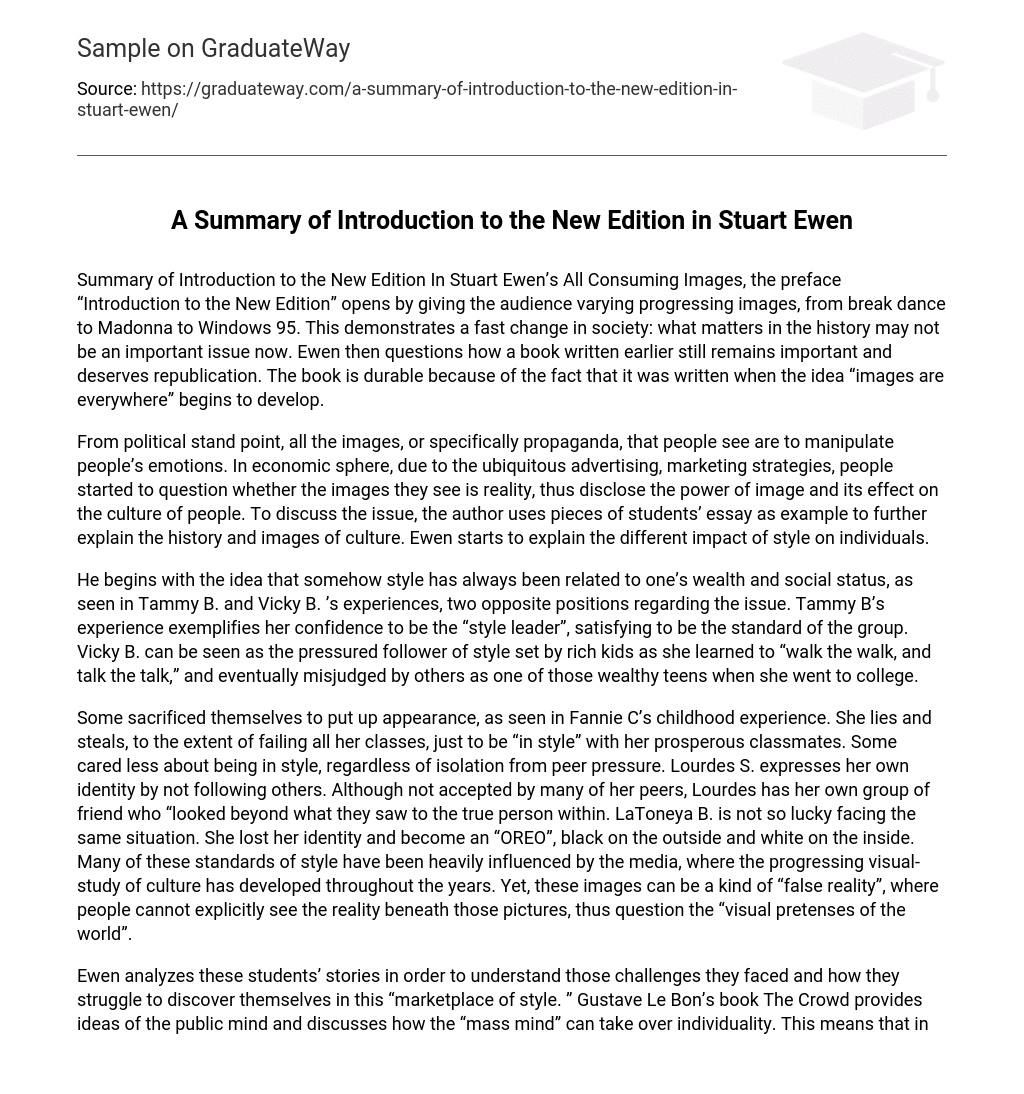Summary of Introduction to the New Edition In Stuart Ewen’s All Consuming Images, the preface “Introduction to the New Edition” opens by giving the audience varying progressing images, from break dance to Madonna to Windows 95. This demonstrates a fast change in society: what matters in the history may not be an important issue now. Ewen then questions how a book written earlier still remains important and deserves republication. The book is durable because of the fact that it was written when the idea “images are everywhere” begins to develop.
From political stand point, all the images, or specifically propaganda, that people see are to manipulate people’s emotions. In economic sphere, due to the ubiquitous advertising, marketing strategies, people started to question whether the images they see is reality, thus disclose the power of image and its effect on the culture of people. To discuss the issue, the author uses pieces of students’ essay as example to further explain the history and images of culture. Ewen starts to explain the different impact of style on individuals.
He begins with the idea that somehow style has always been related to one’s wealth and social status, as seen in Tammy B. and Vicky B. ’s experiences, two opposite positions regarding the issue. Tammy B’s experience exemplifies her confidence to be the “style leader”, satisfying to be the standard of the group. Vicky B. can be seen as the pressured follower of style set by rich kids as she learned to “walk the walk, and talk the talk,” and eventually misjudged by others as one of those wealthy teens when she went to college.
Some sacrificed themselves to put up appearance, as seen in Fannie C’s childhood experience. She lies and steals, to the extent of failing all her classes, just to be “in style” with her prosperous classmates. Some cared less about being in style, regardless of isolation from peer pressure. Lourdes S. expresses her own identity by not following others. Although not accepted by many of her peers, Lourdes has her own group of friend who “looked beyond what they saw to the true person within. LaToneya B. is not so lucky facing the same situation. She lost her identity and become an “OREO”, black on the outside and white on the inside. Many of these standards of style have been heavily influenced by the media, where the progressing visual-study of culture has developed throughout the years. Yet, these images can be a kind of “false reality”, where people cannot explicitly see the reality beneath those pictures, thus question the “visual pretenses of the world”.
Ewen analyzes these students’ stories in order to understand those challenges they faced and how they struggle to discover themselves in this “marketplace of style. ” Gustave Le Bon’s book The Crowd provides ideas of the public mind and discusses how the “mass mind” can take over individuality. This means that in a group of people, the popular mind will replace one’s thought. Like Thomas Hobbes, Le Bon believes that people are irrational, and everything has to be in order or else there will be social instability.
To know the art of impressing the imagination of crowds is to know at the same time the art of governing them…Crowds have always undergone the influence of illusions. Whoever can supply them with illusions is easily their master. When studying the imagination of crowds, we [see] that it is particularly open to the impressions produced by images. A crowd thinks in images, and the image itself immediately calls up a series of other images, having no logical connection with the first…. Ewen 17) Social psychologists have figured out how to control the crowd: to make them impress with images, regardless of it being true or not. Sigmund Freud further presses on Le Bon’s idea to not just the group mind, but also the individual self: how each person has an unconscious mind that awaits rediscovery. This then ties to the image of media and commercial, how its power can persuade and influence people’s mind. In the United States, image-based commercials become the prominent strategies to successfully sell product or help promote candidate election.
Walter Lippmann asserts the importance of “visual rhetoric”, how leaders use it effectively to influence public opinion, narrowing the many different voices into few general opinions. Lippmann especially signifies photography and film as the key communication tools to public persuasion, affecting people’s lives. Photographs become a way of preserving these images; because text needs to be processed while images unconsciously influence people’s mind, the once persuasive tool of writing is soon replaced by the modern rhetoric images.





